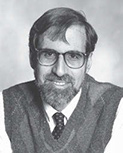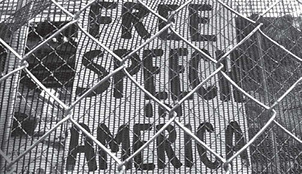
Robert D. Goldstein
SPECIAL SECTION: PSYCHOANALYSIS AND FREE SPEECH
Robert D. Goldstein
Robert D. Goldstein, J.D., is a professor of law at UCLA. His writing includes Mother-Love and Abortion, Child Abuse and Neglect and articles on civil rights, reproductive rights and the first amendment. He is ABD Harvard’s Clinical Psychology and Public Practice Program.

Robert D. Goldstein
A “paradox is involved which needs to be accepted, tolerated, and not resolved,” Winnicott explains of transitional objects in Playing and Reality. Mothers and fathers intuitively understand this, as they do not question the infant’s treating an external object as within his sphere of omnipotence. But it has bedeviled the Supreme Court as it has tried to comprehend the symbolic nature of the American flag in no fewer than eight First Amendment cases involving honoring and desecrating the flag. After reviewing these cases and the Court’s theory of freedom of speech, this article will consider whether the Court’s free speech doctrine, from the point of view of Winnicott and Bion, strains the relationship among speakers that underlies mature communication.
THE SUPREME COURT AND THE AMERICAN FLAG
In 1907, the Court upheld Nebraska’s ban on using the flag for commercial advertising, observing that throughout history “banners, standards, and ensigns have been adopted as symbols of the power and history of the peoples who bore them;” accordingly, Nebraska may “encourage its people to love the Union with which [it] is indissolubly connected.” In 1940, the Court refused to exempt Jehovah’s Witnesses from a public school’s mandatory flag salute and pledge. “We live by symbols,” the Court taught, and the “flag is the symbol of our national unity, transcending all internal differences.…” Because the “ultimate foundation of a free society is the binding tie of cohesive sentiment,” the state can foster what are “almost unconscious feelings:” … “all those agencies of the mind and spirit which may serve to gather up the traditions of a people, transmit them from generation to generation, and thereby create that continuity of a treasured common life.…” Without adopting any one “psychological dogma,” the Court concluded, a legislature could reasonably believe that “the minds” of school age children are at an especially “receptive period of development” for “assimilation” of patriotic sentiments through a “common experience” like the flag salute.

Yet, in 1943, the Court reversed itself and exempted objecting children from the same mandatory salute. This time it offered a deeper view of this symbol: A “flag …is a shortcut from mind to mind,” the Court explained, perhaps intuiting that the flag occupies a transitional space. Accordingly, its meaning must come from within, since “a person gets from a symbol the meaning he puts into it….” For that reason, the Court protected “spontaneous” expression by allowing a person “to speak his own mind” and denying the state the power to coerce even a child, through a flag salute, “to utter what is not in his mind.”
During the Vietnam War, a split Court struggled with allowing protesters expressive leeway in at least three more cases of flag desecration. By contrast, in 1976, in amending the statute that prescribes proper treatment of the flag, Congress declared, The “flag represents a living country and is itself considered a living thing.” As Winnicott notes about a transitional object, “The point of it is not its symbolic value so much as its actuality.”
Finally, following the 1988 presidential election in which the veneration of the flag played a divisive role, the Supreme Court, in a 5-4 decision in Texas v Johnson, reversed Johnson’s conviction for flag burning under a statute forbidding desecration of a venerated object. The Court reasoned that prosecuting the flag-burner impermissibly involved suppressing all ideas about the flag’s meaning except the state’s favored one of “unity.” Anger at the decision almost led Congress to propose a Constitutional amendment; but it was persuaded to respect the symbolic value of an unamended First Amendment by instead adopting a new statute purporting to protect all U.S flags from harm to their physical integrity while leaving their symbolic meaning unregulated. In 1990, the Court, again 5-4, struck down this new statute, as a meaning-making infringement of the flag possessor’s First Amendment rights. The majority and dissent agreed that the law can protect the property interests of flag owners, including the government, from flag burners. But in trying to “protect” a private flag from its owner’s own desecrating treatment, the Court asserted, Congress was actually protecting not the flag’s physical integrity but the particular meaning of national unity this symbol had acquired for many, during 200 years of use. The Court’s opinion advised the outraged viewer of a flag burned in protest to honor that desecrated flag by gathering it up and affording it a proper burial. Under the higher unifying principle of the First Amendment, the Court suggested, a burned flag can still serve its communicative job when multiple viewers invest it with their own meanings. By contrast, the dissent sought to protect from tarnishment a collective investment of the nation in a particular meaning of the flag so that individuals can then find that meaning in their flags. Under the injunction to resolve a case, judges seldom can accept a paradox like Winnicott’s.
THE FIRST AMENDMENT
There are three predominant accounts of the First Amendment. One identifies its function as protecting truth seeking. A second sees it as protecting the autonomous psyche of the speaker and listener, their conscience, their emotions and their thinking capacity. But the predominant theory explains First Amendment doctrine as protecting a realm of public discourse forming “public opinion,” which underwrites democratic legitimacy.
We are not just periodic citizen voters but quotidian citizen critics who participate, without restriction, continuously in a collective dialogue with each other and government officials. This account of freedom of speech assumes that if the First Amendment allowed censorship of speech on matters of public concern, such regulation would easily “chill” speakers from speaking their minds in the realm of public discourse, as few material benefits otherwise encourage such public speech. Yet this account also implicitly assumes that, absent legal deterrence, speakers are object seekers, interested in communicating with others in their political community. Thus, the majority in Johnson assumes that allowing flag burning, under the aegis of the First Amendment, will make public conversation more robust. But this involves treating the flag as a symbol of meaning that must be unregulated rather than as a transitional object, in an intermediate (illusory) space, the protection of which may help individuals believe they are communicating with interested and caring fellow citizens, mind to mind.
LIMITATIONS ON FREE SPEECH
The First Amendment theory of public discourse distinguishes free-for-all speech on matters of public concern in the realm of public discourse from the law’s regulation of speech harmful to the individual personality in civil society (or the “lifeworld”). Thus, tort law has long sought to protect the psyche of the speaker and listener from injurious speech: protecting reputation through the law of defamation; protecting privacy against unreasonable disclosures of spontaneous personal speech and intrusions on the self; protecting audience reliance on speaker sincerity through laws penalizing falsehoods; protecting against outrageous treatment through the tort of infliction of emotional distress; and protecting children in a variety of ways.
Yet during and after the bruising battles of the flag cases, First Amendment doctrine, for a variety of very good reasons, became more protective of speech but also more formally rigid; and as it increasingly constrained various areas of the law, including defamation and privacy, it reduced the law’s protection of the personality of speakers and listeners. This began in earnest during the Vietnam War in Cohen v California, reversing a breach-of-peace arrest for wearing in a courtroom a coat emblazoned with “F*ck the Draft.” Stressing the importance of emotional expression to free speech (as the “emotive function…may often be the more important element of the overall message”), the Court held that, in public space, the audience (such as a family with its toddlers in tow) must simply avert their eyes and not expect the law to protect them from “mere” offense.
In rapid succession, three cases reversed arrests for a defendant’s use of “mother f*cker” in public settings. In 1988, the Court rejected an emotional distress claim against Hustler Magazine brought by the Moral Majority leader Jerry Falwell for the magazine’s “parody” portraying incest with his mother. In 2011, because it denied that it could distinguish a minor’s physically playing video games from reading a book, the Court struck down a law regulating juvenile access to violent video games. Characterizing an anti-abortion protester’s “quiet counseling” of patients entering Planned Parenthood facilities as speech of public, not private, concern, the Court recently struck down a law securing unencumbered access to clinics. Finally, members of the Westboro Church, with a slogan “God Hates Fags,” picketed, from a public location, the funeral of a U.S. Marine who was killed in combat. Finding the church’s protest against the nation’s evolving laws on homosexuality a matter of public concern, the Court reversed the jury’s award of damages to the Marine’s grieving father for infliction of emotional distress.
What are the psychological consequences of cases such as these? The justices argue that the regime of free speech itself protects and nurtures a strong personality, capable of self-governance (and less likely, in the words of Erich Fromm, to seek an escape from freedom). In his famous free speech opinion, in Whitney v California (1927), Justice Louis D. Brandeis discussed the favorable impact free speech has on the character development of democratic citizens. Cathartic expression integrates individuals within the community, reduces hate and liberates “thought, hope and imagination.” Most important, tolerance of frustration, arising from confrontation with the reality of diverse minds with diverse opinions, builds character. For Brandeis, free speech paves the ego’s way to healthy reality testing: “It is the function of speech to free men from the bondage of irrational fears.”
COLLECTIVE CONVERSATION AND GROUP PSYCHOLOGY
Free speech doctrine allocates to the realm of public discourse the work of expressing political interests and deliberating for collective action, what Justice Brandeis in Whitney called “political truth.” We should expect that such a realm of our collective conversation will be periodically subject to the predictable phenomena of group psychology. This includes the regressive emotional group attitudes that Bion found regularly interfere with the work of a group, and which he attributed to the members’ loss of ego boundaries, interpersonal support and social roles in an unstructured group. Bion identified three alternating basic group assumptions: passive dependency on an idealized leader, unrealistic hopes of being saved by a charismatic couple, and a scapegoating fight-flight group in a persecutory, paranoid state. Indeed, in Whitney, Brandeis expressed the expectation that free speech would, through reality testing, counteract such primitive group anxiety, noting that in an earlier (pre First Amendment) time, “Men feared witches and burnt women.”

Photo: Joeff Davis
Even as it prevents government censorship, does free speech doctrine sometime undermine the conditions that support mature speakers in public discourse? Might denying a shared transitional object (like the flag) that facilitates connection among our vast citizenry, and might reducing the law’s restraint on attacks on the integrity of our personalities increase the regressive pulls of group anxiety? In Cohen v California, Justice John Marshall Harlan expressed the hope that free speech doctrine “will ultimately produce a more capable citizenry.” In limiting the power to proscribe “mere offense” in a society “as diverse and populous as ours,” he also acknowledged that the doctrine of “free expression is powerful medicine.” But he did not explain for what malady and whether this medicine is ever iatrogenic.